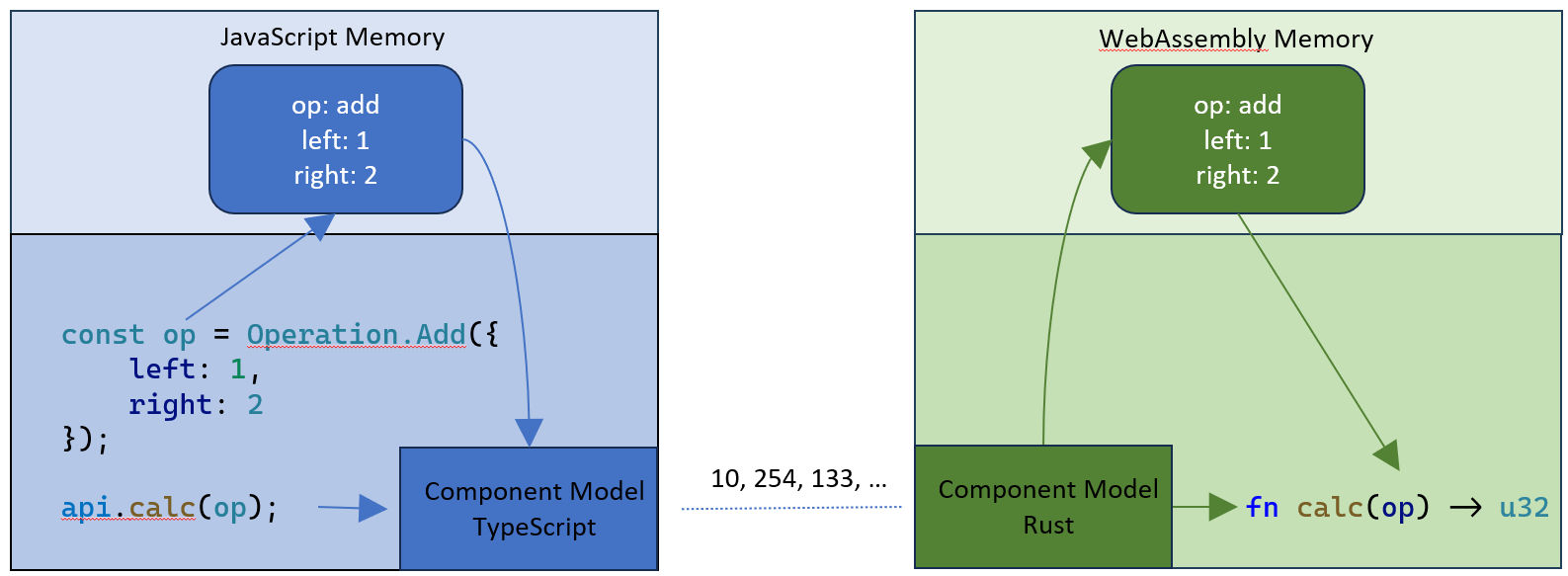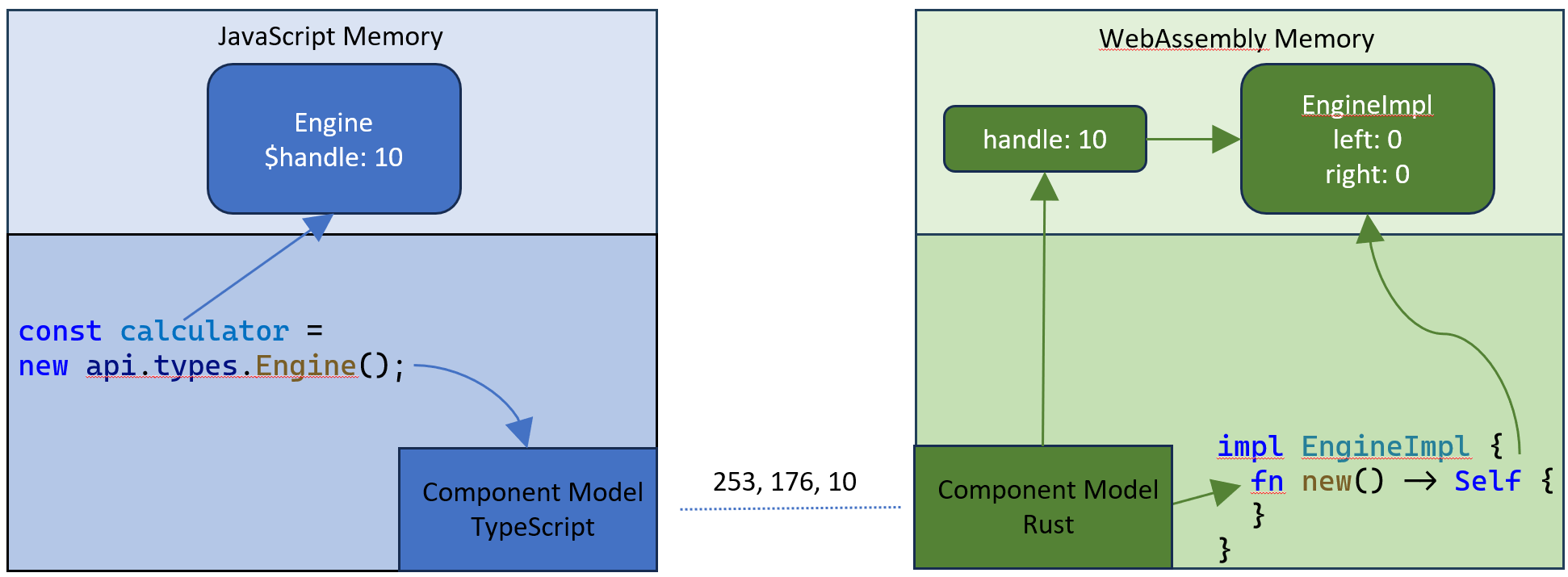使用WebAssembly进行扩展开发
2024年5月8日,作者:Dirk Bäumer
Visual Studio Code 支持通过 WebAssembly 执行引擎 扩展来执行 WASM 二进制文件。主要用例是将用 C/C++ 或 Rust 编写的程序编译成 WebAssembly,然后直接在 VS Code 中运行这些程序。一个显著的例子是 Visual Studio Code for Education,它利用此支持在 VS Code for the Web 中运行 Python 解释器。这篇 博客文章 提供了关于如何实现这一点的详细见解。
2024年1月,Bytecode联盟发布了WASI 0.2预览版。WASI 0.2预览版中的一项关键技术是组件模型。WebAssembly组件模型通过标准化接口、数据类型和模块组合,简化了WebAssembly组件与其宿主环境之间的交互。这种标准化是通过使用WIT(WASM接口类型)文件来实现的。WIT文件有助于描述JavaScript/TypeScript扩展(宿主)与执行用另一种语言(如Rust或C/C++)编写的计算的WebAssembly组件之间的交互。
这篇博客文章概述了开发者如何利用组件模型将WebAssembly库集成到他们的扩展中。我们重点关注三个用例:(a) 使用WebAssembly实现一个库并从JavaScript/TypeScript的扩展代码中调用它,(b) 从WebAssembly代码中调用VS Code API,以及(c) 演示如何使用资源来封装和管理WebAssembly或TypeScript代码中的有状态对象。
示例要求您安装以下工具的最新版本,以及VS Code和NodeJS:rust compiler toolchain、wasm-tools和wit-bindgen。
我还想感谢来自Fastly的L. Pereira和Luke Wagner对本文的宝贵反馈。
Rust中的计算器
在第一个示例中,我们演示了开发者如何将用Rust编写的库集成到VS Code扩展中。如前所述,组件使用WIT文件进行描述。在我们的示例中,库执行简单的操作,如加法、减法、乘法和除法。相应的WIT文件如下所示:
package vscode:example;
interface types {
record operands {
left: u32,
right: u32
}
variant operation {
add(operands),
sub(operands),
mul(operands),
div(operands)
}
}
world calculator {
use types.{ operation };
export calc: func(o: operation) -> u32;
}
Rust工具wit-bindgen用于为计算器生成Rust绑定。有两种使用此工具的方式:
-
作为一个过程宏,直接在实现文件中生成绑定。这种方法虽然标准,但有一个缺点,即不允许检查生成的绑定代码。
-
作为一个命令行工具,它在磁盘上创建一个绑定文件。这种方法在VS Code扩展示例仓库中的代码中得到了体现,用于下面的资源示例。
对应的Rust文件,使用wit-bindgen工具作为过程宏,如下所示:
// Use a procedural macro to generate bindings for the world we specified in
// `calculator.wit`
wit_bindgen::generate!({
// the name of the world in the `*.wit` input file
world: "calculator",
});
然而,使用命令cargo build --target wasm32-unknown-unknown将Rust文件编译为WebAssembly时,由于缺少导出的calc函数的实现,会导致编译错误。以下是calc函数的一个简单实现:
// Use a procedural macro to generate bindings for the world we specified in
// `calculator.wit`
wit_bindgen::generate!({
// the name of the world in the `*.wit` input file
world: "calculator",
});
struct Calculator;
impl Guest for Calculator {
fn calc(op: Operation) -> u32 {
match op {
Operation::Add(operands) => operands.left + operands.right,
Operation::Sub(operands) => operands.left - operands.right,
Operation::Mul(operands) => operands.left * operands.right,
Operation::Div(operands) => operands.left / operands.right,
}
}
}
// Export the Calculator to the extension code.
export!(Calculator);
文件末尾的export!(Calculator);语句从WebAssembly代码中导出Calculator,以便扩展能够调用API。
wit2ts 工具用于生成必要的 TypeScript 绑定,以便在 VS Code 扩展中与 WebAssembly 代码进行交互。该工具由 VS Code 团队开发,以满足 VS Code 扩展架构的特定需求,主要是因为:
- VS Code API 只能在扩展主机工作线程中访问。从扩展主机工作线程生成的任何额外工作线程都无法访问 VS Code API,这与 NodeJS 或浏览器等环境形成对比,在这些环境中,每个工作线程通常都可以访问几乎所有的运行时 API。
- 多个扩展共享同一个扩展主机工作线程。扩展应避免在该工作线程上执行任何长时间运行的同步计算。
这些架构要求在我们实现VS Code的WASI预览版1时已经存在。然而,我们的初始实现是手动编写的。预计组件模型将得到更广泛的采用,我们开发了一个工具,以促进组件与其VS Code特定主机实现的集成。
命令 wit2ts --outDir ./src ./wit 在 src 文件夹中生成一个 calculator.ts 文件,包含 WebAssembly 代码的 TypeScript 绑定。一个利用这些绑定的简单扩展如下所示:
import * as vscode from 'vscode';
import { WasmContext, Memory } from '@vscode/wasm-component-model';
// Import the code generated by wit2ts
import { calculator, Types } from './calculator';
export async function activate(context: vscode.ExtensionContext): Promise<void> {
// The channel for printing the result.
const channel = vscode.window.createOutputChannel('Calculator');
context.subscriptions.push(channel);
// Load the Wasm module
const filename = vscode.Uri.joinPath(
context.extensionUri,
'target',
'wasm32-unknown-unknown',
'debug',
'calculator.wasm'
);
const bits = await vscode.workspace.fs.readFile(filename);
const module = await WebAssembly.compile(bits);
// The context for the WASM module
const wasmContext: WasmContext.Default = new WasmContext.Default();
// Instantiate the module
const instance = await WebAssembly.instantiate(module, {});
// Bind the WASM memory to the context
wasmContext.initialize(new Memory.Default(instance.exports));
// Bind the TypeScript Api
const api = calculator._.exports.bind(
instance.exports as calculator._.Exports,
wasmContext
);
context.subscriptions.push(
vscode.commands.registerCommand('vscode-samples.wasm-component-model.run', () => {
channel.show();
channel.appendLine('Running calculator example');
const add = Types.Operation.Add({ left: 1, right: 2 });
channel.appendLine(`Add ${api.calc(add)}`);
const sub = Types.Operation.Sub({ left: 10, right: 8 });
channel.appendLine(`Sub ${api.calc(sub)}`);
const mul = Types.Operation.Mul({ left: 3, right: 7 });
channel.appendLine(`Mul ${api.calc(mul)}`);
const div = Types.Operation.Div({ left: 10, right: 2 });
channel.appendLine(`Div ${api.calc(div)}`);
})
);
}
当你在VS Code for the Web中编译并运行上述代码时,它会在Calculator通道中产生以下输出:
您可以在VS Code 扩展示例仓库中找到此示例的完整源代码。
深入 @vscode/wasm-component-model
检查由wit2ts工具生成的源代码,可以发现它依赖于@vscode/wasm-component-model npm模块。该模块作为组件模型的规范ABI的VS Code实现,并受到相应Python代码的启发。虽然理解这篇博客文章不需要理解组件模型的内部工作原理,但我们将对其工作机制进行一些说明,特别是关于如何在JavaScript/TypeScript和WebAssembly代码之间传递数据。
与其他工具如wit-bindgen或jco不同,这些工具为WIT文件生成绑定,而wit2ts创建了一个元模型,然后可以用于在运行时为各种用例生成绑定。这种灵活性使我们能够满足VS Code中扩展开发的架构要求。通过使用这种方法,我们可以“promisify”绑定,并允许在工作者中运行WebAssembly代码。我们采用这种机制来实现WASI 0.2预览用于VS Code。
你可能已经注意到,在生成绑定时,函数是通过像calculator._.imports.create这样的名称引用的(注意下划线)。为了避免与WIT文件中的符号发生名称冲突(例如,可能有一个名为imports的类型定义),API函数被放置在一个_命名空间中。元模型本身则位于一个$命名空间中。因此,calculator.$.exports.calc表示导出的calc函数的元数据。
在上面的例子中,传递给calc函数的add操作参数由三个字段组成:操作码、左值和右值。根据组件模型的规范ABI,参数是按值传递的。它还概述了数据如何被序列化、传递给WebAssembly函数,并在另一端反序列化。这个过程产生了两个操作对象:一个在JavaScript堆上,另一个在线性WebAssembly内存中。下图说明了这一点:

下表列出了可用的WIT类型,它们在VS Code组件模型实现中映射到JavaScript对象的方式,以及使用的相应TypeScript类型。
| WIT | JavaScript | TypeScript |
|---|---|---|
| u8 | number | type u8 = number; |
| u16 | number | type u16 = number; |
| u32 | number | type u32 = number; |
| u64 | bigint | type u64 = bigint; |
| s8 | number | type s8 = number; |
| s16 | number | type s16 = number; |
| s32 | number | type s32 = number; |
| s64 | bigint | type s64 = bigint; |
| float32 | number | type float32 = number; |
| float64 | number | type float64 = number; |
| bool | boolean | boolean |
| string | string | string |
| char | string[0] | string |
| record | object literal | type declaration |
| list<T> | [] | Array<T> |
| tuple<T1, T2> | [] | [T1, T2] |
| enum | string values | string enum |
| flags | number | bigint |
| variant | object literal | discriminated union |
| option<T> | variable | ? and (T | undefined) |
| result<ok, err> | Exception or object literal | Exception or result type |
需要注意的是,组件模型不支持低级(C风格)指针。因此,您不能传递对象图或递归数据结构。在这方面,它与JSON有相同的限制。为了最小化数据复制,组件模型引入了资源的概念,我们将在本博客文章的后续部分中更详细地探讨这一点。
jco项目也支持使用type命令为WebAssembly组件生成JavaScript/TypeScript绑定。如前所述,我们开发了自己的工具以满足VS Code的特定需求。然而,我们与jco团队每两周举行一次会议,以确保在可能的情况下工具之间的一致性。一个基本要求是,两个工具应该对WIT数据类型使用相同的JavaScript和TypeScript表示。我们还在探索在两个工具之间共享代码的可能性。
从WebAssembly代码调用TypeScript
WIT文件描述了主机(一个VS Code扩展)与WebAssembly代码之间的交互,促进双向通信。在我们的示例中,此功能允许WebAssembly代码记录其活动的跟踪。为了实现这一点,我们按如下方式修改WIT文件:
world calculator {
/// ....
/// A log function implemented on the host side.
import log: func(msg: string);
/// ...
}
在 Rust 方面,我们现在可以调用 log 函数:
fn calc(op: Operation) -> u32 {
log(&format!("Starting calculation: {:?}", op));
let result = match op {
// ...
};
log(&format!("Finished calculation: {:?}", op));
result
}
在TypeScript方面,扩展开发者唯一需要采取的行动是提供日志函数的实现。然后,VS Code组件模型会促进必要绑定的生成,这些绑定将作为导入传递给WebAssembly实例。
export async function activate(context: vscode.ExtensionContext): Promise<void> {
// ...
// The channel for printing the log.
const log = vscode.window.createOutputChannel('Calculator - Log', { log: true });
context.subscriptions.push(log);
// The implementation of the log function that is called from WASM
const service: calculator.Imports = {
log: (msg: string) => {
log.info(msg);
}
};
// Create the bindings to import the log function into the WASM module
const imports = calculator._.imports.create(service, wasmContext);
// Instantiate the module
const instance = await WebAssembly.instantiate(module, imports);
// ...
}
与第一个示例相比,WebAssembly.instantiate 调用现在包括了 calculator._.imports.create(service, wasmContext) 的结果作为第二个参数。这个 imports.create 调用从服务实现中生成了低级的 WASM 绑定。在最初的示例中,我们传递了一个空的对象字面量,因为不需要任何导入。这次,我们在 VS Code 桌面环境的调试器下执行扩展。感谢 Connor Peet 的出色工作,现在可以在 Rust 代码中设置断点,并使用 VS Code 调试器逐步执行。
使用组件模型资源
WebAssembly组件模型引入了资源的概念,它提供了一种标准化的机制来封装和管理状态。这种状态在调用边界的一侧(例如,在TypeScript代码中)进行管理,并在另一侧(例如,在WebAssembly代码中)进行访问和操作。资源在WASI预览版0.2 API中被广泛使用,文件描述符是一个典型的例子。在这种设置中,状态由扩展主机管理,并由WebAssembly代码进行访问和操作。
资源也可以反向工作,其状态由WebAssembly代码管理,并由扩展代码访问和操作。这种方法对于VS Code在WebAssembly中实现有状态服务特别有益,这些服务随后从TypeScript端访问。在下面的示例中,我们定义了一个资源,该资源实现了一个支持逆波兰表示法的计算器,类似于惠普手持计算器中使用的计算器。
// wit/calculator.wit
package vscode:example;
interface types {
enum operation {
add,
sub,
mul,
div
}
resource engine {
constructor();
push-operand: func(operand: u32);
push-operation: func(operation: operation);
execute: func() -> u32;
}
}
world calculator {
export types;
}
以下是Rust中计算器资源的简单实现:
impl EngineImpl {
fn new() -> Self {
EngineImpl {
left: None,
right: None,
}
}
fn push_operand(&mut self, operand: u32) {
if self.left == None {
self.left = Some(operand);
} else {
self.right = Some(operand);
}
}
fn push_operation(&mut self, operation: Operation) {
let left = self.left.unwrap();
let right = self.right.unwrap();
self.left = Some(match operation {
Operation::Add => left + right,
Operation::Sub => left - right,
Operation::Mul => left * right,
Operation::Div => left / right,
});
}
fn execute(&mut self) -> u32 {
self.left.unwrap()
}
}
在TypeScript代码中,我们以与之前相同的方式绑定导出。唯一的区别是,绑定过程现在为我们提供了一个代理类,用于在WebAssembly代码中实例化和管理calculator资源。
// Bind the JavaScript Api
const api = calculator._.exports.bind(
instance.exports as calculator._.Exports,
wasmContext
);
context.subscriptions.push(
vscode.commands.registerCommand('vscode-samples.wasm-component-model.run', () => {
channel.show();
channel.appendLine('Running calculator example');
// Create a new calculator engine
const calculator = new api.types.Engine();
// Push some operands and operations
calculator.pushOperand(10);
calculator.pushOperand(20);
calculator.pushOperation(Types.Operation.add);
calculator.pushOperand(2);
calculator.pushOperation(Types.Operation.mul);
// Calculate the result
const result = calculator.execute();
channel.appendLine(`Result: ${result}`);
})
);
当你运行相应的命令时,它会在输出通道中打印Result: 60。如前所述,资源的状态驻留在调用边界的一侧,并通过句柄从另一侧访问。除了传递给与资源交互的方法的参数外,不会发生数据复制。

此示例的完整源代码可在VS Code 扩展示例仓库中找到。
直接从Rust使用VS Code API
组件模型资源可以用于封装和管理跨WebAssembly组件和宿主的状态。这种能力使我们能够利用资源将VS Code API规范地暴露到WebAssembly代码中。这种方法的优势在于整个扩展可以用编译为WebAssembly的语言编写。我们已经开始探索这种方法,下面是一个用Rust编写的扩展的源代码:
use std::rc::Rc;
#[export_name = "activate"]
pub fn activate() -> vscode::Disposables {
let mut disposables: vscode::Disposables = vscode::Disposables::new();
// Create an output channel.
let channel: Rc<vscode::OutputChannel> = Rc::new(vscode::window::create_output_channel("Rust Extension", Some("plaintext")));
// Register a command handler
let channel_clone = channel.clone();
disposables.push(vscode::commands::register_command("testbed-component-model-vscode.run", move || {
channel_clone.append_line("Open documents");
// Print the URI of all open documents
for document in vscode::workspace::text_documents() {
channel.append_line(&format!("Document: {}", document.uri()));
}
}));
return disposables;
}
#[export_name = "deactivate"]
pub fn deactivate() {
}
请注意,这段代码类似于用TypeScript编写的扩展。
尽管这次探索看起来很有前景,但我们决定暂时不继续推进。主要原因是WASM缺乏异步支持。许多VS Code API是异步的,这使得它们难以直接代理到WebAssembly代码中。我们可以在一个单独的worker中运行WebAssembly代码,并采用与WASI Preview 1支持中相同的同步机制,在WebAssembly worker和扩展主机worker之间进行同步。然而,这种方法在同步API调用时可能会导致意外行为,因为这些调用实际上会异步执行。因此,在两个同步调用之间,可观察的状态可能会发生变化(例如,setX(5); getX();可能不会返回5)。
此外,我们正在努力在0.3预览版时间框架内为WASI引入完整的异步支持。Luke Wagner在WASM I/O 2024上提供了关于当前异步支持状态的更新。我们决定等待这一支持,因为它将实现更完整和干净的实现。
如果您对相应的WIT文件、Rust代码和TypeScript代码感兴趣,您可以在vscode-wasm仓库的rust-api文件夹中找到它们。
接下来是什么
我们目前正在准备一篇后续的博客文章,将涵盖更多可以使用WebAssembly代码进行扩展开发的领域。主要主题将包括:
- 编写语言服务器在WebAssembly中。
- 使用生成的元模型将长时间运行的WebAssembly代码透明地卸载到单独的工作线程中。
在VS Code中实现了组件模型的惯用实现后,我们继续努力为VS Code实现WASI 0.2预览。
谢谢,
Dirk 和 VS Code 团队
编程快乐!